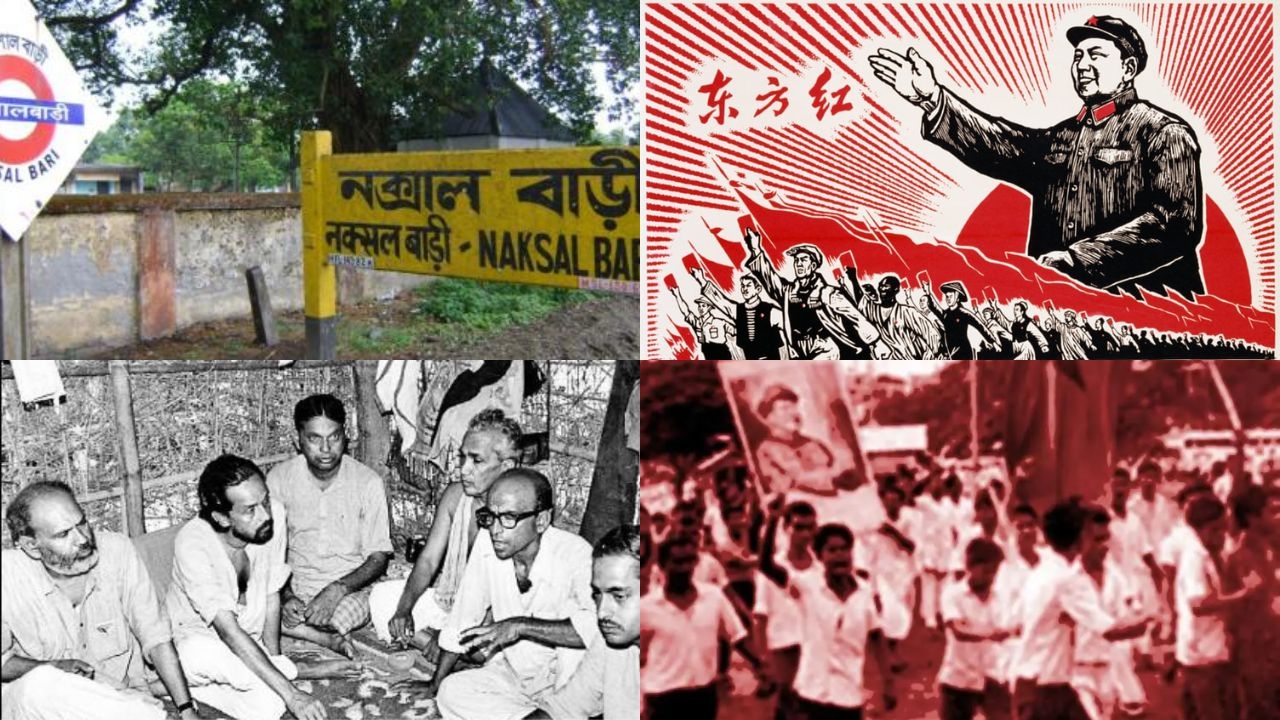From Chicken's Neck to Naxalbari: The Birth and Spread of Communist Terrorism in Bharat
21 Aug 2024 06:30:15

Though the area is endearingly called the "Chicken's Neck" in India, it is much more than a geographical term; it is actually a historical and political flashpoint, belying profound implications. Officially, this narrow stretch of land is referred to as the Siliguri Corridor and connects the northeastern states of India to the rest of the country.

Given that it is surrounded by four countries—Nepal, Bhutan, Bangladesh, and China—it has always been hugely important for strategic purposes. The geopolitical significance notwithstanding, the Chicken's Neck assumes a very important place in the history of Naxalism—the insurgency that changed the internal security landscape of India forever since its formation in the late 1960s.
The Historical and Geopolitical Context of the Chicken's Neck
The Chicken's Neck is a narrow strip of land, only about 22 kilometres wide, that serves as the lifeline to India's northeastern states from its mainland. Such a thin corridor is open to blockades or invasions and hence forms an area of prime importance for national security.
Historically, it has always been an amalgamation of people of different ethnicities—the Bengalis, the Nepalis, the Biharis, and local tribes like the Rajbanshis and Lepchas. This mix has often led to ethnic tensions and conflicts, another factor that further complicates the security dynamics in the region.
It was during the 1962 Sino-Indian War, when Chinese forces advanced towards the corridor, underpinning much of the region's strategic interest, that the Chicken's Neck came into their notice and prominence.
The situation has only added complexity to the region, which lies in close proximity to the volatile borders of Bangladesh, Nepal, and Bhutan. Against this backdrop of geopolitical tension, economic disparity, and social restlessness, perhaps, the seeds of Naxalism were sown.
The Genesis of Naxalism
Naxalism is named after the village of Naxalbari, located in West Bengal's Darjeeling district. It began as a peasant uprising during 1967 by way of an armed struggle against landlords by poor peasants and sharecroppers.

It imbibed the spirit of Mao Zedong's ideology at its roots, with deep anguished feelings against the feudal landholding system and all-pervasive poverty and social injustice. The insurgency was centred in Naxalbari, next to Chicken's Neck, and later on spread all over India.
The immediate provocation for the Naxalbari uprising was a land dispute between peasants of the area and the landlord classes. On 25 May 1967, this violent confrontation between peasants led by the local leaders Charu Majumdar and Kanu Sanyal with landlords occurred, killing a police officer.
This marked the beginning of a radical communist insurgency that aimed to overthrow the state through an armed struggle, advocating land and resource redistribution.
The Role of the Chicken's Neck in the Spread of Naxalism
The Chicken's Neck proved to be the most vital factor in the spread of Naxalism due to its location, combined with the extant socio-economic conditions across it.
The area lay close to the porous borders with Nepal and Bangladesh, which granted the radicals an ideal base from which to conduct guerrilla warfare.
The dense forests, the hilly terrain, and the socio-political obstacles holding major chunks of the nation back made it hard for the state to counter the growing insurgency.
The Naxalites capitalised on the impoverishment of the local tribal and peasant populations, who were long bruised under the yoke of an oppressive landlord class, insensitive regime of policies by the government, and customs that have held them in a tight vise.
The movement soon expanded from Naxalbari to other parts of West Bengal, then to Bihar, Odisha, Andhra Pradesh, and beyond. The Chicken's Neck became a conduit for the expansion of the movement because Naxalite leaders established links with sympathetic groups in neighbouring Nepal and Bangladesh, further strengthening their cause.
The Ideological Underpinnings of Naxalism
Naxalism was heavily influenced by Maoism, emphasising armed struggle and the need for mobilisation of the rural peasantry against the ruling classes. Drawing upon Mao's radical experiences in China—especially the concept of a "protracted people's war"—the movement focused on building a strong base in the rural areas and then advanced towards urban centres.

Charu Majumdar, one of the key leaders of the insurgency, enunciated this ideology of Naxalism through what is known as his "Historic Eight Documents." These documents provided the strategy for the insurgency, laying out a plan that encompassed the violent overthrow of the state, to be replaced by a "people's government." Majumdar was of the view that India was ready for a Communist insurgency because people in villages suffered from poverty, exploitation, and general discontent.
The slogan "Land to the tiller" was adopted by the Naxalites, who wanted to tear down the ongoing feudal structure through armed struggle. This struggle was against landlords, moneylenders, and state officials—whom they considered agents of oppression. It also aimed at solving acute problems that prevailed in rural areas like caste discrimination, landlessness, and unemployment.
The Impact of Naxalism on the Chicken's Neck Region
The rise of Naxalism had its deep influence in the Chicken's Neck region. With armed struggle and a sort of radical ideology, the insurgency went on to create a cycle of violence and repression in that region.
The response by the state was in terms of forces, deployment of paramilitary units, and running of counter-insurgency operations to quell the uprising. This ensuing violence resulted in wide-scale displacement, loss of life, and thousands living in fear and insecurity.
The Naxalite insurgency was witness to the destruction of the social fabric of the region, as the traditional hierarchies were challenged and age-old grievances brought to the fore.
This insurgency exacerbated already existent tensions between different ethnic groups, particularly in areas where land disputes were common. It was very bad for the economic development of the region, scaring away investment and leading to deteriorated infrastructure and public services.
The Decline and Resurgence of Naxalism
By the early 1970s, the Naxalite terrorism had started to decline, including because of internal divisions, state repression, and the death of key leaders such as Charu Majumdar. All this set off all kinds of splinter groups from the movement, each having its own agenda.
Nevertheless, Naxalism, as a phenomenon, never really burnt out; it continued to simmer in different parts of the country, particularly along the "Red Corridor" that stretches from Bihar to Andhra Pradesh.
Naxalism resurfaced in the late 1990s and the following year of 2000, catalysed by the constant marginalisation of rural and tribal communities, and its activities rose in states like Chhattisgarh, Jharkhand, and Odisha with local grievances, which had given new impetus towards the insurgency. Naxals have been gradually using more sophisticated ways of fighting, such as the use of IEDs and ambushes, which makes them an increasingly real challenge to the state.
The Present-Day Situation and the Way Forward
Naxalism is one of the major internal security challenges that India is still facing today. Though much of its ideological fervour and mass support got depleted, it continues to remain in some parts of the country.
The response of the government has been resolved through a mix of military action and development initiatives that address the root causes of this insurgency, such as poverty, landlessness, and lack of access to basic services like health and education.
Though the Chicken's Neck region is no longer the epicentre of Naxalism, it still remains strategically important to the state. Infrastructural construction and enhancement of security have been carried out in this state so that the rising movement does not come into effect once again.
But during the process, economic disparity and social injustice—the roots of Naxalism—have still gone unattended, making the region again vulnerable for future agitations.
Conclusion
The Chicken's Neck represents a unique geographical and socio-political landscape which served to be the bed from which Naxalism arose within India. Originating as a peasant uprising in the Naxalbari area, it spread geometrically across the length and breadth of the country and has affected the internal security and socio-political formation of India.
The strength of Naxalism has weakened over the years, but the issues that had given birth to it—landlessness, poverty, deprivation, and social injustice—still exist, and with all due respect, this gives the requirement that only by an alternative, more inclusive, and more equitable development model can there be a chance for the involvement of much more than aspirations, particularly those of its people hailing from marginalised and conflict-prone regions such as Chicken's Neck.
Article by
Shomen Chandra
Sub Editor, The Narrative